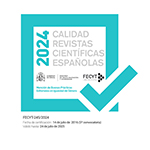Language / Culture Distance and Linguistic / Cultural Transfer: Its Effects in the Learning Process of English as a Foreign Language
Abstract
The learning of a foreign language is influenced by a number of factors including the effects of the distance between the source language and culture, and the target language and culture. In this article our aim is to highlight the fact that successful acquisition will depend on the characteristics of the linguistic and cultural behaviour of the learners, as well as on their associative knowledge related to their linguistic and cultural background. This empirical study focuses on the cross-linguistic and cross-cultural influence of Spanish on the acquisition of English as a foreign language. The central objective is to observe if the mother tongue and culture promote or hinder the acquisition of English as a second language. The subjects in this study are Spanish-speaking students in the first year of the Translation and Interpreting Degree at the University of Las Palmas de Gran Canaria, Spain. The data analysed confirms that while the perception of similarities between languages and cultures can facilitate learning, language and culture transfer may cause non-native forms (errors) to occur.
Downloads
Article download
License
In order to support the global exchange of knowledge, the journal Didáctica. Lengua y Literatura is allowing unrestricted access to its content as from its publication in this electronic edition, and as such it is an open-access journal. The originals published in this journal are the property of the Complutense University of Madrid and any reproduction thereof in full or in part must cite the source. All content is distributed under a Creative Commons Attribution 4.0 use and distribution licence (CC BY 4.0). This circumstance must be expressly stated in these terms where necessary. You can view the summary and the complete legal text of the licence.










